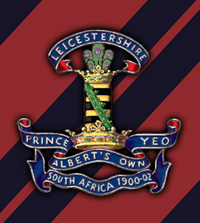Leicestershire Yeomanry
| The Leicestershire Yeomanry (Prince Albert's Own) | |
|---|---|

Cap badge of The Leicestershire Yeomanry (P.A.O)
|
|
| Active | 1794–1802 1803–1957 |
| Country |
|
| Branch |
|
| Type | Yeomanry |
| Size | Regiment |
| HQ | Leicester |
| Nickname(s) | Albert Lads |
| Patron | Albert, Prince Consort |
| Motto(s) | "vultus en hostem" face the enemy |
| March | Regimental March by Henry Nicholson jnr (1825-1907) |
| Mascot(s) | Veld Baboon, "Adonse", from 1901 until his demise. Buried in Woodhouse Eves, Leicestershire. |
| Engagements | |
| Battle honours | See battle honours below |
Second Boer War
First World War
The Leicestershire Yeomanry (Prince Albert's Own) was a yeomanry regiment of the British Army, first raised in 1794 and again in 1803, which provided cavalry and mounted infantry in the Second Boer War and the First World War and provided two field artillery regiments of the Royal Artillery in the Second World War, before being amalgamated with the Derbyshire Yeomanry into forming the Leicestershire and Derbyshire (Prince Albert's Own) Yeomanry in 1957. The regiment's lineage is currently perpetuated by B (LDY) Squadron of the Royal Yeomanry.
During the crisis of 1794, when there were grave fears of a French invasion, the government pressed for the formation of volunteer corps across the country, and in April 1794, letters were circulated to the Lords Lieutenant of each county instructing them to raise regiments of yeomanry. In Leicestershire, a meeting was held at the Three Crowns Inn in Leicester on 10 April, where the details were organised and a list of subscribers who were willing to provide funds made out. The colonelcy was given to Sir William Skeffington, a retired Major in the Grenadier Guards, dated 9 May, and he and Captain Curzon kissed the King's hand on 11 June to report that they had raised their full complement of men. The regiment paraded in six troops on 4 July to receive their standards.
...
Wikipedia
